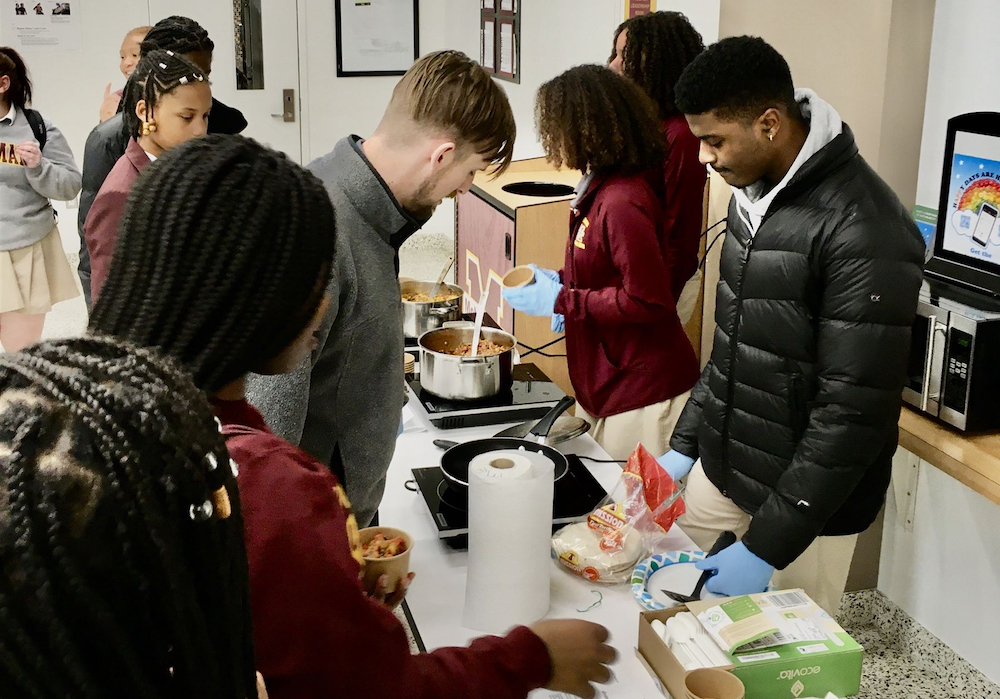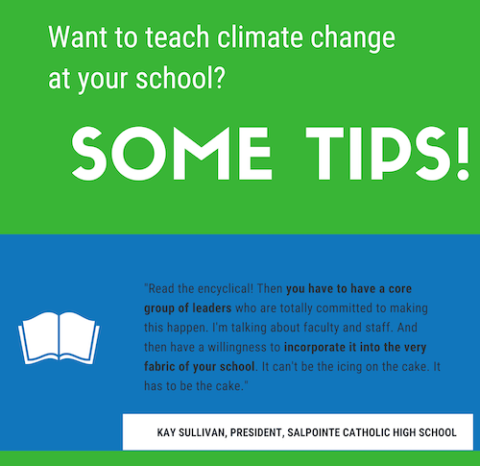
Members of Bishop McNamara High School's Ecology Explorers Club, Forestville, Maryland, make vegetarian soup to share with other students to show how they can reduce their carbon footprint. (Jan Steeger)
If one group in particular has taken the lead in climate activism, it's students.
Although their momentum has been temporarily stalled by the coronavirus shutdown, students have made use of strikes, addresses to world leaders and countless demonstrations to build an inclusive global movement that puts environmental justice at the forefront of climate debates.
But what's a student without a teacher?
Studies have shown that quality environmental education helps build critical thinking and problem solving skills, improves academic success at schools across the curriculum, and makes learning more exciting for both students and teachers.
Outside the classroom, researchers also point to students' potential to influence their parents' views on climate change, or induce a widespread social tipping point to rapidly transition to carbon-neutral societies.
As Pope Francis wrote in "Laudato Si': on Care for Our Common Home," "education can encourage ways of acting which directly and significantly affect the world around us."
To learn how Catholic high schools are helping shape this new generation of leaders, NCR spoke with 11 teachers and administrators from across the country. Although methods and content varied from school to school, we found all of the educators were resolute on one principle: the importance of empowering and encouraging students to believe in their own ability to make a difference.
Salpointe Catholic High School, Tucson, Arizona
Salpointe is the first high school in the country to have implemented a schoolwide "Laudato Si' Curriculum."
The curriculum, developed in partnership with the Carmelite NGO in 2015, is a set of lesson plans that connects material already being covered to themes in Laudato Si'. It includes lessons for classes across all disciplines and grade levels in an effort to "give high school students — at such a crucial time in their development — values necessary to ensure the earth's future," according to the Carmelite NGO website.
Topics covered in the curriculum range from things like stressing the importance of potable water to the rights of indigenous people. The full curriculum is available for download here.
"The approach we've been taking is we want to inform and empower our students and show them all these different small lifestyle changes," said Ellen Fisher, education technology coach.
According to theology teacher Kate McGarey-Vasey, the curriculum's greatest strength is in the flexibility it provides teachers to pull out messages from the encyclical of their choosing. Because the document is so rich, she said, there is no shortage of possible angles. And because Salpointe's entire faculty was given bound copies of the encyclical to read, teachers know it pretty well.
Two Bishop O'Dowd High School students enjoy the Oakland, California, campus' Living Lab. (Courtesy of Bishop O'Dowd High School)
Bishop O'Dowd High School, Oakland, California
For the second year in a row, O'Dowd is offering an upper-level elective course titled, "Spiritual Ecology" — the first of its kind in the country.
The course was developed in collaboration between the religious studies and sustainability departments. Over three units and using Laudato Si' as a textbook, students explore kinship with creation. Here's how O'Dowd's magazine described each unit:
- "Our common home" invites students to become aware of God's presence in this present moment and the earth, taking stock of what is happening to our common home.
- "Listening to the cry of the earth" includes an overview of the past relationships of humans with nature.
- "Creating sacred space" challenges students to look toward the future, by designing a project in the Living Lab (the school's outdoor classroom), develop habits in sustainable living, and committing to spiritual practices that keep them close to the earth.
Michael Downs, O'Dowd's director of justice and kinship who helped design the course, told NCR's EarthBeat that an important element of the class is its local focus. Students learn the story of their specific bioregion in northern California, including the history of its indigenous people.
Downs said he has developed a template of guiding questions available for schools and teachers in other parts of the country who might want to teach spiritual ecology.
Stone Ridge School of the Sacred Heart, Bethesda, Maryland
Last spring, in 2019, Stone Ridge School of the Sacred Heart hosted its first ever climate change symposium.
The daylong event was the culmination of the school's "climate change interdisciplinary project," created by science teachers Joanna Caudle and Heidi Johnson. The project had teachers from all disciplines find ways to incorporate climate change into what their students were learning in classes. The goal was to help students understand the interconnectedness of the issue.
The symposium took the form of a pseudo-conference, where students led different sessions to their peers about what they learned in class. Students and teachers found a variety of creative ways to present what they learned, including:
- A simulation of a Senate Agriculture Committee meeting by the Advanced Placement government class students
- Small-scale renewable energy projects built by the engineering students
- Public service announcements on the health effects of climate change by the AP biology class students
- A poetry presentation from the English department.
Students were also given the opportunity to participate in an environmental scavenger hunt or workshops that taught them such skills as how to write letters to their representatives in Congress.
"After that symposium, students felt very empowered," Johnson said. "These are teenagers, and they're hearing in the news all of the dire circumstances that seem to be unfolding due to climate change. So the one major thing that we wanted the girls to walk away with was hope that things can be done and that they can also make a difference as well."
Advertisement
DePaul College Prep, Chicago, Illinois
At DePaul College Prep, the theology department covers climate change in three courses: sacred scriptures, morality and social justice.
In teacher Justin Lane's sacred scriptures class, climate change is incorporated into an early unit on Genesis. After students discuss such ideas as care for creation and stewardship, they watch segments from National Geographic's "Before the Flood," including one where Leonardo DiCaprio interviews Pope Francis. After watching the movie, students then read the introduction to Laudato Si' where Francis makes a few references to the creation story.
The final assignment of the unit asks students to write a letter to their future grandchildren. Students have to discuss the current climate situation, use Laudato Si' to justify the importance of good stewardship and, finally, to say what they hope the world is like for their grandchildren.
Lane said the assignment works "because it gets students to think about what our situation is now," as well as "why it is their responsibility, their goal, their duty to take care and be good stewards."
Bishop McNamara High School, Forestville, Maryland
Instead of teaching climate change in a separate unit, the science department at Bishop McNamara works climate change into various units when it's relevant.
For example, when science teacher Jan Steeger teaches photosynthesis, she makes sure to point out how plants' absorption of carbon throughout that process can help reduce the amount of carbon dioxide in the atmosphere contributing to climate change.
Steeger said that she thinks revisiting climate change at different points in the curriculum makes students more aware generally.
Another science teacher has a simple back-and-forth she does with her students as much as possible, when relevant. "And why is this happening?" she'll ask her students about a phenomenon the class is covering. "Climate change," the students eagerly reply.
[Jesse Remedios is a staff writer with National Catholic Reporter's EarthBeat and former NCR Bertelsen intern. His email address is jremedios@ncronline.org. Follow him on Twitter: @JCRemedios]









